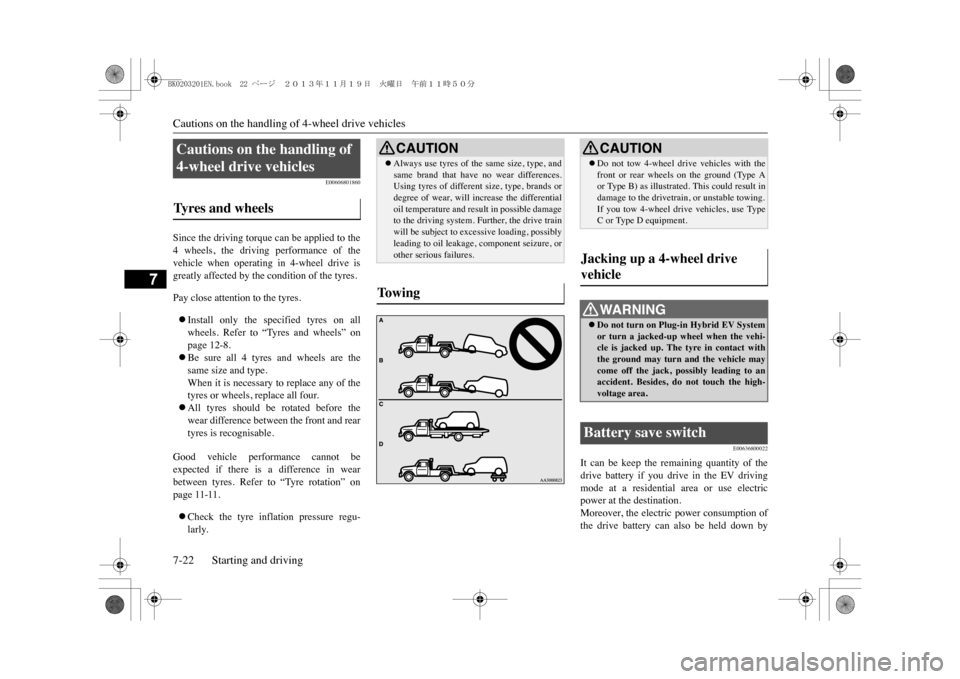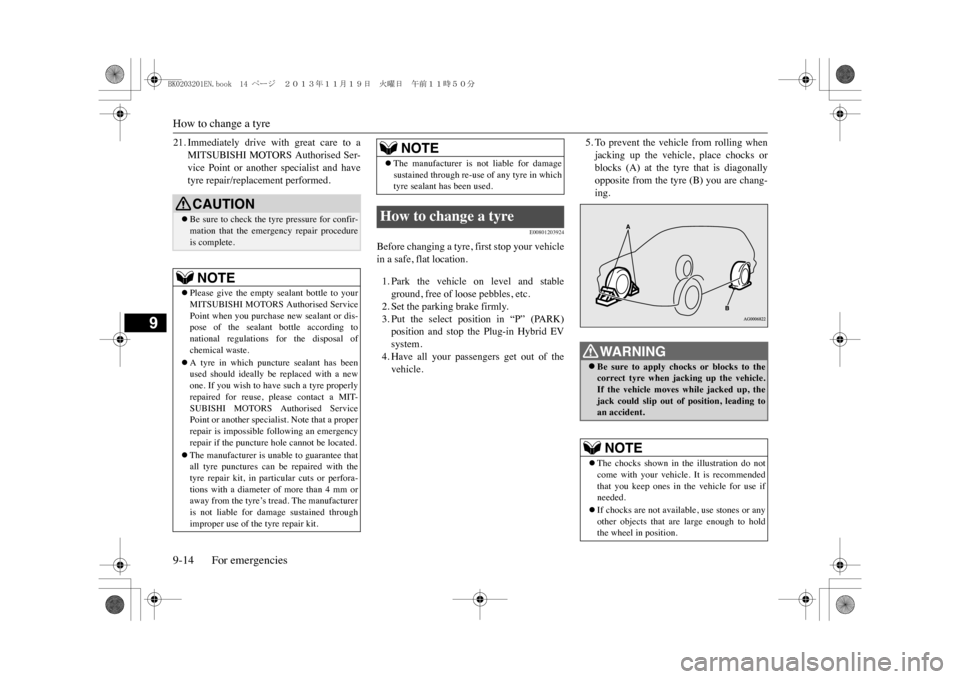Page 185 of 388

Cautions on the handling of 4-wheel drive vehicles7-22 Starting and driving
7
E00606801860
Since the driving torque can be applied to the4 wheels, the driving performance of thevehicle when operating in 4-wheel drive isgreatly affected by the condition of the tyres.Pay close attention to the tyres.�zInstall only the specified tyres on allwheels. Refer to “Tyres and wheels” onpage 12-8.�zBe sure all 4 tyres and wheels are thesame size and type.When it is necessary to replace any of thetyres or wheels, replace all four.�zAll tyres should be rotated before thewear difference between the front and reartyres is recognisable.
Good vehicle performance cannot beexpected if there is a difference in wearbetween tyres. Refer to “Tyre rotation” onpage 11-11.�zCheck the tyre inflation pressure regu-larly.
E00636800022
It can be keep the remaining quantity of thedrive battery if you drive in the EV drivingmode at a residential area or use electricpower at the destination.Moreover, the electric power consumption ofthe drive battery can also be held down by
Cautions on the handling of 4-wheel drive vehicles Ty r e s a n d w h e e l s
CAUTION�zAlways use tyres of the same size, type, andsame brand that have no wear differences.Using tyres of different size, type, brands ordegree of wear, will increase the differentialoil temperature and result in possible damageto the driving system. Further, the drive trainwill be subject to exce
ssive loading, possibly
leading to oil leakage, component seizure, orother serious failures.
To w i n g
CAUTION�zDo not tow 4-wheel driv
e vehicles with the
front or rear wheels on the ground (Type Aor Type B) as illustrated. This could result indamage to the drivetrain, or unstable towing.If you tow 4-wheel drive vehicles, use TypeC or Type D equipment.
Jacking up a 4-wheel drive vehicle
WA R N I N G�zDo not turn on Plug-in Hybrid EV Systemor turn a jacked-up wheel when the vehi-cle is jacked up. The tyre in contact withthe ground may turn and the vehicle maycome off the jack, possibly leading to anaccident. Besides, do not touch the high-voltage area.
Battery save switch
BK0203201EN.book 22 ページ 2013年11月19日 火曜日 午前11時50分
Page 325 of 388

How to change a tyre9-14 For emergencies
9
21. Immediately drive with great care to a
MITSUBISHI MOTORS Authorised Ser-vice Point or another specialist and havetyre repair/replacement performed.
E00801203924
Before changing a tyre, first stop your vehiclein a safe, flat location.1. Park the vehicle on level and stableground, free of loose pebbles, etc.2. Set the parking brake firmly.3. Put the select position in “P” (PARK)position and stop the Plug-in Hybrid EVsystem.4. Have all your passengers get out of thevehicle.
5. To prevent the vehicle from rolling whenjacking up the vehicle, place chocks orblocks (A) at the tyre that is diagonallyopposite from the tyre (B) you are chang-ing.
CAUTION�zBe sure to check the tyre pressure for confir-mation that the emergency repair procedureis complete.NOTE
�zPlease give the empty sealant bottle to yourMITSUBISHI MOTORS Authorised ServicePoint when you purchase new sealant or dis-pose of the sealant bottle according tonational regulations for the disposal ofchemical waste.�zA tyre in which puncture sealant has beenused should ideally be
replaced with a new
one. If you wish to have
such a tyre properly
repaired for reuse, please contact a MIT-SUBISHI MOTORS Authorised ServicePoint or another specialist. Note that a properrepair is impossible fo
llowing an emergency
repair if the puncture hole cannot be located.�zThe manufacturer is unable to guarantee thatall tyre punctures can be repaired with thetyre repair kit, in particular cuts or perfora-tions with a diameter
of more than 4 mm or
away from the tyre’s tread. The manufactureris not liable for damage sustained throughimproper use of the tyre repair kit.
�zThe manufacturer is not liable for damagesustained through re-use of any tyre in whichtyre sealant has been used.
How to change a tyre
NOTE
WA R N I N G�zBe sure to apply choc
ks or blocks to the
correct tyre when jacking up the vehicle.If the vehicle moves while jacked up, thejack could slip out of
position, leading to
an accident.NOTE
�zThe chocks shown in the illustration do notcome with your vehicle. It is recommendedthat you keep ones in the vehicle for use ifneeded.�zIf chocks are not available, use stones or anyother objects that are large enough to holdthe wheel in position.
BK0203201EN.book 14 ページ 2013年11月19日 火曜日 午前11時50分
Page 326 of 388

How to change a tyre
For emergencies 9-15
9
6. Get the jack, jack bar and wheel nutwrench ready.Refer to “Tools and jack” on page 9-6.
E00803201894
1. On vehicles with wheel covers, firstremove the covers (refer to “Wheel cov-ers” on page 9-18).Then loosen the wheel nuts a quarter turnwith the wheel nut wrench. Do notremove the wheel nuts yet.
2. Place the jack under one of the jackingpoints (A) shown in the illustration. Usethe jacking point closest to the tyre youwish to change.
3. Rotate the jack by hand until the flangeportion (B) fits in the groove (C) at the topof the jack.4. Insert the jack bar (D) into the wheel nutwrench (E). Then put the end of the jackbar into the shaft’s jack end, as shown inthe illustration.Slowly rotate the wheel nut wrench untilthe tyre is raised slightly off the groundsurface.
To c h a n g e a t y r e
WA R N I N G�zSet the jack only at the positions shownhere. If the jack is set at a wrong position,it could dent your vehicle or the jackmight fall over and cause personal injury.�zDo not use the jack on a tilted or soft sur-face.Otherwise, the jack might slip and causepersonal injury. Always use the jack on aflat, hard surface. Before setting the jack,make sure there are no sand or pebblesunder the jack base.
BK0203201EN.book 15 ページ 2013年11月19日 火曜日 午前11時50分